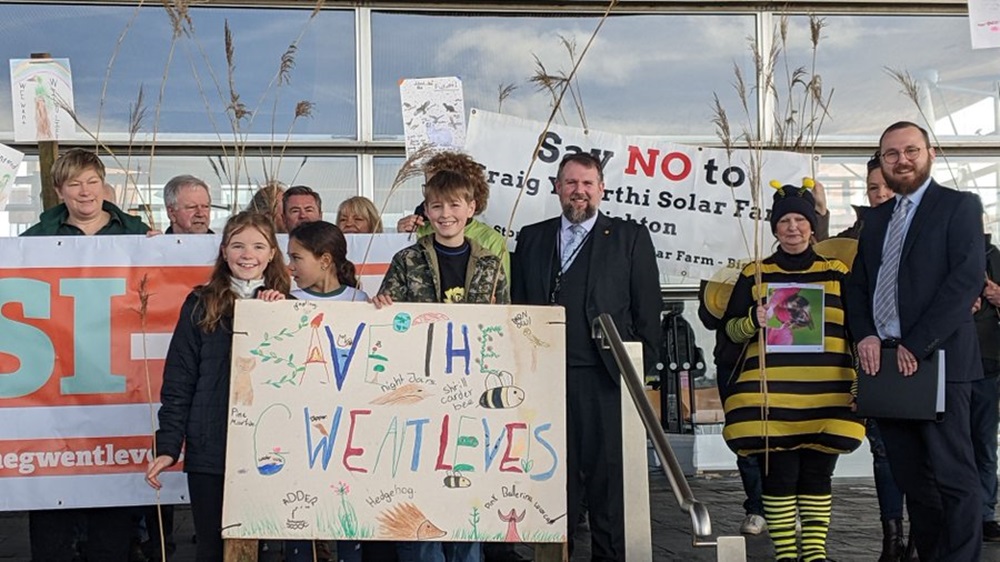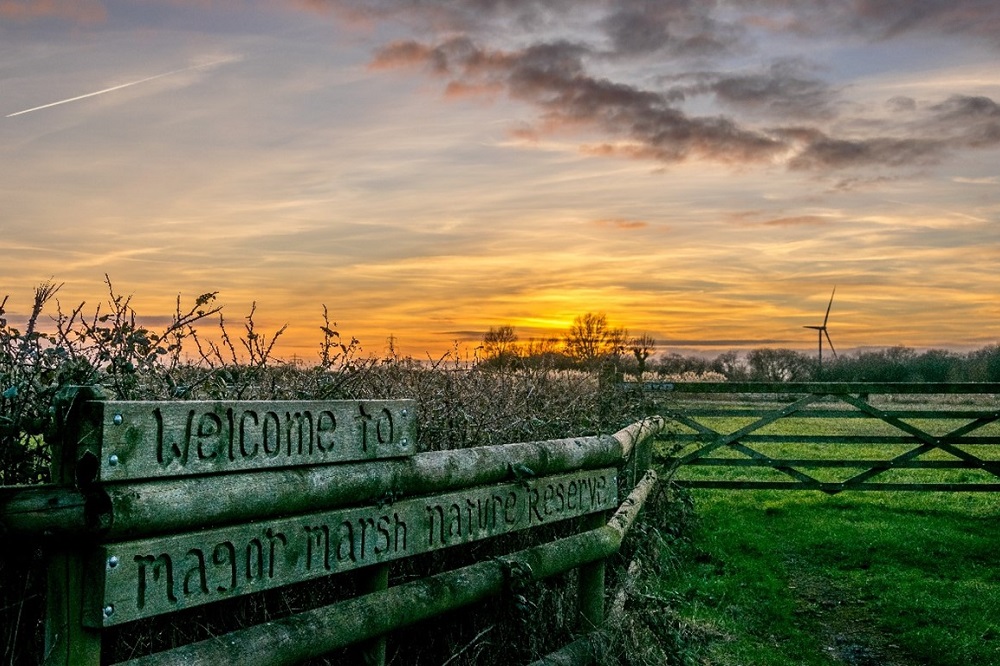Gwent Levels campaigners hold demo at Senedd

Martin Shipton
More than 100 people turned up on the steps of the Senedd to voice their support for protecting the Gwent Levels as the Petitions Committee prepared to debate the Gwent Wildlife Trust petition “Halt significant new development on the Gwent Levels SSSIs [Sites of Special Scientific Interest]”.
GWT was joined by a host of supporters including Levels farmers and residents, community groups, young Wildlife Warriors, Friends of Gwent Levels, and opponents of the huge Craig-y-Perthi solar power station they argue will engulf the village and oust neighbouring tenant farmers.
The Craig-y-Perthi project is being taken forward by JBM Solar, a part of RWE, the UK’s leading power generator.
Iolo Williams
GWT’s petition also has the support of TV naturalists Iolo Williams, Gillian Burke and Lizzie Daly, author and broadcaster Mary Colwell, and internationally acclaimed author, Julian Hoffman.
Adam Taylor, GWT CEO said: “The importance of protecting the Gwent Levels, a beautiful, fragile, complex wetland area, teeming with wildlife cannot be over-emphasised. This landscape is of immense value to both human wellbeing and wildlife, and it’s vital that it’s protected.”
In an impassioned address to the assembled crowd, GWT planning manager Mike Webb said: “Some politicians don’t appear to understand the value of the Gwent Levels, and think that this is where they can dump all their bad neighbour developments. They do not understand either how passionately we care about this landscape, and the wonders contained within it.
“We need to protect it for our future, as I do not want Welsh children to grow up in a landscape covered in a sea of glass, and tarmac and concrete, with no lapwings, bees, wildflower meadows or skylarks to bring joy and wellbeing.”
Third generation Levels resident and farmer, Ceri Hoffrock, opponent of the massive Craig-y-Perthi solar power station, said: “This colossal development will engulf thousands of acres, destroying our community, and the stunning landscape around us. And this is not the only huge power station proposal.
“If all these developments go ahead, the heart will be ripped out of the Gwent Levels SSSI, along with the nature that depends on it, and the livelihood of farmers who have worked here for generations. The harm will be catastrophic.”
Gwent Wildlife Trust and supporters were keen to drum the message home: “We will not be going away. This is a landscape worth fighting for, and we will continue to do so,” said Mr Webb.
Diversity of wildlife
The Gwent Levels provide a mosaic of habitats that nurture a rich diversity of wildlife throughout the year. The distinctive, familiar but increasingly rare sound of cuckoo calling heralds the fact that spring is in full swing, while the reeds and scrub house the elusive Cetti’s Warbler, its wonderful call piercing the air. In summer, wildflowers carpet the meadows, and the air is full of insects as they feed on the nectar-rich flowers. As autumn approaches, it’s the best time to see a brilliant flash of colour as kingfishers dart along the waterways.
Flocks of teal and shoveler make the ponds their winter home. Throughout the year, the waterways known as reens are frequented by water voles (one of the UK’s fastest declining mammals) and otters.

One of the trust’s flagship reserves is Magor Marsh on the Gwent Levels.
Magor Marsh is one of the last remaining pieces of natural fenland that once covered the Levels. Wetlands like this were once commonplace across Britain but they are now one of the UK’s most threatened habitats.
It was the threat of losing this important place in the 1960s that brought local naturalists together to fight for its survival, banding together to form what is now known as the Gwent Wildlife Trust. More recently, Barecroft Common was added to the reserve along with neighbouring Bridewell Common, extending this important habitat for the benefit of the natural world.
The Gwent Levels are one of the largest surviving areas of ancient grazing marsh and reen (drainage ditch) systems in Britain and is the largest of its kind in Wales. Thanks to several nationally significant archaeological finds, the Gwent Levels has been designated a ‘Landscape of Outstanding Historic Interest’. Its biodiversity significance is recognised both nationally and internationally.
This ancient landscape has been carefully and purposefully managed by man for thousands of years. Prehistoric footprints preserved in the mud of the nearby estuary shows this was a hunting ground for early man. The man-made reens that criss-cross the area are thought to date back to Roman times.
Climate change
A statement on JBM Solar’s website says: “Climate change has undoubtedly become the defining issue of our time and to respond to this crisis the UK has made a commitment to achieve a net zero fully decarbonised power grid by 2035.
“This can only be achieved through the rapid adoption and roll-out of affordable and clean energy sources like solar.
“Similarly, Newport City Council declared a climate and ecological emergency in 2021, setting a number of ambitious targets including achieving net zero by 2030. Solar farms such as Craig-y-Perthi will make a meaningful contribution to both local and national climate commitments, and help tackle both the climate and cost of living crises we face.”
“The Craig Y Perthi Solar Farm would be located between the M4 and the Llanwern Steelworks, to the east of Llanwern, and to the east/west of Bishton, in Newport, south Wales.The solar farm would be able to meet the equivalent energy needs of 45,374 Welsh homes and save over 3,180,000 tonnes of CO2. That’s the equivalent of planting over 52 million trees.
“The site would be preserved as greenfield before, during, and after it is decommissioned, safeguarding the area from industrial/residential development. Large, open, green spaces will also be created across the site for residents to use and enjoy on otherwise private land.”
Support our Nation today
For the price of a cup of coffee a month you can help us create an independent, not-for-profit, national news service for the people of Wales, by the people of Wales.








The campaigners are right, there should be no new development on the Gwent Levels SSSI!
As quoted in the article “Newport City Council declared a climate and ecological emergency in 2021.” Any development will damage the ecology of the Levels!
The correct decision (not to proceed) was taken with the m4 relief road to protect the levels, the Craig Y Perthi Solar Farm should, and must, be rejected!
Its your opinion that it was the correct decision not to build the M4 relief motorway, yet you will find that the vast majority of people in Newport and it’s surrounding area will vehemently disagree with you.
This is yet another tail wagging the dog scenario in which the views of the majority are completely disregarded.
Good for them! Developments of any kind should be nowhere near the Gwent Levels and its fragile wildlife, such a shame they even have to be fighting this instead of focussing on other priorities
A solar development would be a great way of protecting the levels. Think of the benefits;
1. Less intensive grazing
2. More wildflower and habitat creation
3. Significantly less pesticide and fertiliser
4. More space for nature as human interaction will drop dramatically
5. Create local job opportunities and skills development
The wider environmental benefits in reducing carbon emissions far out way other perceived impacts. The main thing everyone worries about is visual. The wildlife don’t see that – they see greater available habitat and havens away from modern farming techniques.
This is a fragile and complex ecosystem. The one existing solar farm on the Levels has already caused significant harm, and the supposed benefits are not delivered by the developers, who take the money and run all the way to the bank. We need to protect our SSSIs. We haven’t run out of space for solar farms on non-protected sites, so that’s where they should go. And btw, no benefit for local job opportunities.